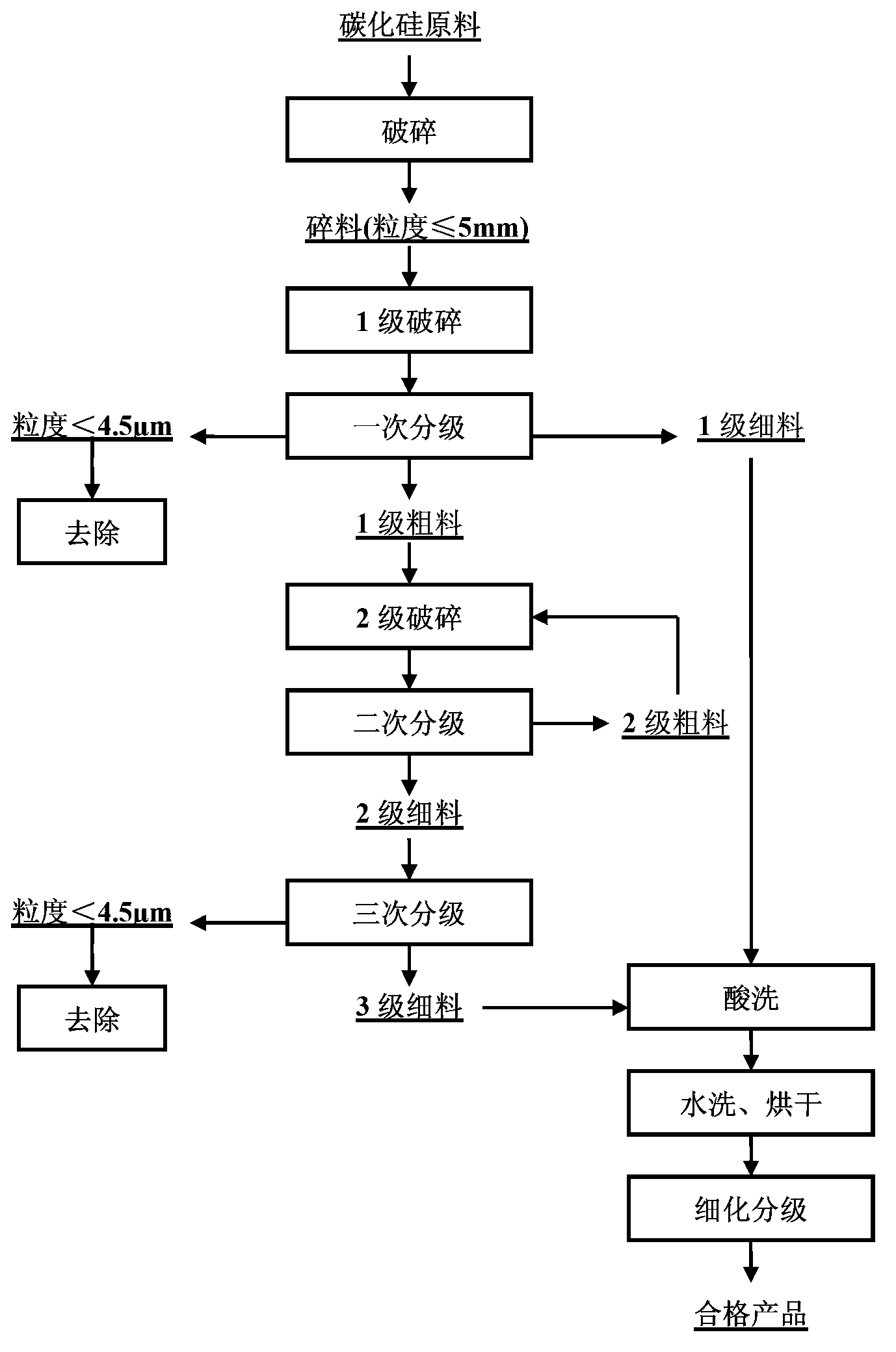Preparation method of silicon carbide cutting edge materials for photovoltaic industry
A silicon carbide and cutting edge technology, applied in the direction of silicon carbide, carbide, etc., can solve the problems of high energy consumption, low output rate and high roundness value of silicon carbide blade material, so as to improve the quality of slices, improve the cutting efficiency, The effect of increasing productivity
- Summary
- Abstract
- Description
- Claims
- Application Information
AI Technical Summary
Problems solved by technology
Method used
Image
Examples
Embodiment 1
[0022] 1. Break the silicon carbide raw material into pieces, the particle size of which is ≤5mm;
[0023] 2. Use Raymond Mill for primary crushing of the crushed materials. When the particle size of the crushed materials is 4.5~15 μm accounting for 28% of the total weight of the total crushed materials, the wind classifier is used for primary classification, and the separated particle size is > 15 μm The part with a particle size of 4.5-15 μm is regarded as a first-grade fine material, and the part with a particle size of less than 4.5 μm is removed;
[0024] 3. Use Raymond Mill as the primary raw material for secondary crushing. When the secondary raw material has a particle size of 4.5-15 μm accounting for 80% of the total weight of the secondary raw material, use a wind classifier for secondary crushing. Classification, the part with a particle size > 15 μm is regarded as the second-grade coarse material, the part with a particle size ≤ 15 μm is regarded as the second-grad...
Embodiment 2
[0029] 1. Break the silicon carbide raw material into pieces, the particle size of which is ≤5mm;
[0030] 2. Use a ball mill for primary crushing of the crushed material. When the particle size of the crushed material is 4.5~15μm accounting for 29% of the total weight of the total crushed material, the wind classifier is used for primary classification, and the separated particle size > 15μm As a grade 1 coarse material, the part with a particle size of 4.5~15 μm is regarded as a grade 1 fine material, and the part with a particle size of less than 4.5 μm is removed;
[0031] 3. Use the ball mill as the primary raw material to carry out secondary crushing. When the particle size of the secondary raw material is 4.5~15μm accounts for 81% of the total weight of the secondary raw material, use a hydraulic classifier for secondary classification. Parts with a particle size > 15 μm are classified as Class 2 coarse materials, and those with a particle size ≤ 15 µm are classified as...
Embodiment 3
[0036] 1. Break the silicon carbide raw material into pieces, the particle size of which is ≤5mm;
[0037] 2. Use Raymond mill to carry out primary crushing of the crushed materials. When the particle size of the crushed materials is 4.5~15μm accounting for 30% of the total weight of the total crushed materials, the wind classifier is used for primary classification, and the separated particle size is >15μm The part with a particle size of 4.5-15 μm is regarded as a first-grade fine material, and the part with a particle size of less than 4.5 μm is removed;
[0038] 3. Use the first-grade coarse material as the secondary raw material and use the jet mill to carry out the second-grade crushing. When the part of the secondary raw material with a particle size of 4.5-15 μm accounts for 82% of the total weight of the secondary raw material, use the wind classifier for secondary classification , the separated part with a particle size > 15 μm is regarded as the second-grade coarse ...
PUM
| Property | Measurement | Unit |
|---|---|---|
| particle size | aaaaa | aaaaa |
| particle size | aaaaa | aaaaa |
| particle size | aaaaa | aaaaa |
Abstract
Description
Claims
Application Information
 Login to View More
Login to View More - R&D
- Intellectual Property
- Life Sciences
- Materials
- Tech Scout
- Unparalleled Data Quality
- Higher Quality Content
- 60% Fewer Hallucinations
Browse by: Latest US Patents, China's latest patents, Technical Efficacy Thesaurus, Application Domain, Technology Topic, Popular Technical Reports.
© 2025 PatSnap. All rights reserved.Legal|Privacy policy|Modern Slavery Act Transparency Statement|Sitemap|About US| Contact US: help@patsnap.com

